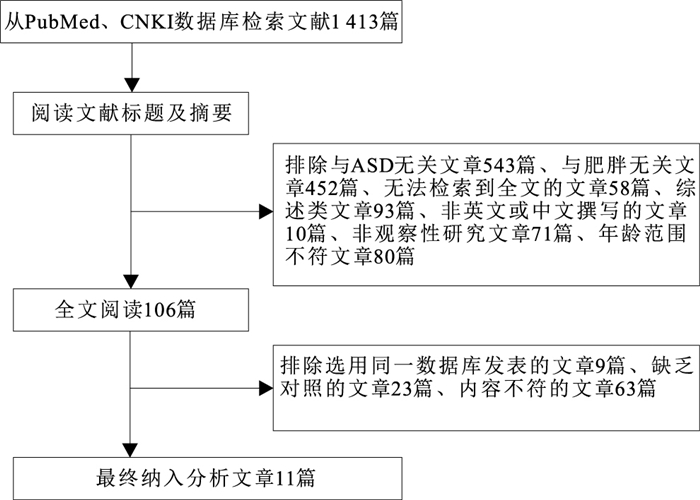Cumulative Meta-analysis of the association between obesity and autism spectrum disorders in children and adolescents
-
摘要:
目的 对肥胖和孤独症谱系障碍(ASD)流行病学研究进行Meta分析,以探究儿童青少年孤独症谱系障碍和肥胖之间的关联,为改善ASD儿童青少年患者日常生活质量提供一定指导作用。 方法 系统检索PubMed、CNKI(2010年1月—2022年1月)中与肥胖、ASD相关的文献,采用Meta分析报告OR值。并对权重、体质量指数(BMI)获得方式、年龄等分类指标进行亚组分析。 结果 共筛选11篇文献纳入分析,总样本包括336 830名参与者,其中ASD患者58 187名,正常发育者278 643名。经Meta分析,与正常人相比,ASD儿童青少年有更高的肥胖发病风险(OR=1.80,95%CI=1.74~1.86)。根据BMI获得方式分组后,与正常人相比,BMI由客观测量、从病历中获得、父母报告获得的ASD患者有更高的肥胖发病风险,OR值(OR值95%CI)分别为1.43(1.04~1.96),5.23(4.44~6.16),2.57(1.79~3.69)。根据年龄分组后,与正常人相比,14~20岁ASD儿童青少年患者有更高的肥胖发病风险,OR值(OR值95%CI)=2.19(1.21~3.94)。 结论 相较于正常发育同龄人,ASD儿童青少年患者发生肥胖的风险更高。应在饮食、体力活动方面正确引导ASD患者,尤其是在青春期,避免其发生肥胖及肥胖引起的其他疾病。 Abstract:Objective This study conducts a Meta-analysis on the epidemiological studies of obesity and autism spectrum disorder (ASD) in order to explore the relationship between autism spectrum disorder and obesity in children and adolescents, and to provide some guidance for improving the quality of daily life of children and adolescents with ASD. Methods PubMed and CNKI (January, 2010-January, 2022) were systematically searched for literature related to autism spectrum disorders reported the or value by Meta-analysis, and compared the weight, BMI acquisition method. Results A total of 11 literatures were selected for analysis. The total sample included 336 830 participants, including 58 187 patients with ASD and 278 643 patients with normal development. Through Meta-analysis, children and adolescents with ASD had a higher risk of obesity than normal people (OR=1.80, 95%CI=1.74-1.86). when stratified by BMI acquisition, autistic patients with BMI obtained from objective measurement, medical records and parents' reports had a higher risk of obesity than normal people, and the OR value (95%CI) was 1.43(1.04-1.96), 5.23(4.44-6.16), 2.57(1.79-3.69). When stratified by age, children and adolescents with ASD aged 14 to 20 years had a higher risk of obesity than normal people. The OR value (95%CI) was 2.19(1.21-3.94). Conclusion Compared with healthy peers, children and adolescents with ASD have a higher risk of obesity. ASD patients need guidance in diet and physical activity, especially in adolescence, to prevent obesity or diseases caused by obesity. -
Key words:
- Autistic disorder /
- Obesity /
- Meta-analysis /
- Child /
- Adolescent
1) 利益冲突声明 所有作者声明无利益冲突。 -
表 1 纳入文献的基本资料
Table 1. Basic data included in the study
第一作者与发表时间 国家 年龄/岁 ASD人数 正常发育人数 OR值(OR值95%CI) ASD诊断方法 BMI获得方式 纽卡斯尔-渥太华评估总分 Barnhill[12](2016) 美国 3~8 86 57 1.33(0.38~4.66) SCQ,ADI-R,ADOS 客观测量 6 Bicer[13](2016) 美国 6~8 118 97 1.77(1.02~3.09) DSM-IV,DSM-V 客观测量 8 Broder-Fingert[4](2014) 美国 2~20 2 976 3 696 5.23(4.44~6.16) ICD-9 从病历中获得 7 Castro[14](2016) 巴西 6~13 49 49 2.58(1.02~6.52) DSM-IV 客观测量 6 Hill[15](2015) 美国 2~17 5 053 8 844 1.10(1.00~1.20) DSM-IV,ADOS 客观测量 8 Kummer[16](2016) 巴西 4~12 69 19 5.00(0.62~40.56) DSM-V 客观测量 7 Liu[17](2016) 中国 3~7 154 73 0.42(0.19~0.91) DSM-V 客观测量 8 Phillips[18](2014) 美国 12~17 93 8 141 3.16(2.04~4.90) 父母报告 父母报告 6 Rimmer[19](2010) 美国 14~16 159 12 973 2.18(1.51~3.13) 父母报告 父母报告 6 Shedilock[20](2016) 美国 2~18 48 762 243 810 1.85(1.78~1.92) ICD-9-CM 客观测量 8 Levy[21](2019) 美国 2~5 668 884 1.57(1.24~2.00) ADOS,SCQ,ADI-R,DSM-V 客观测量 7 注:SCQ为社会沟通问卷,ADI-R为孤独症诊断访谈量表(修订版),ADOS为孤独症诊断观察时间表,DSM-IV为《诊断和统计手册》第4版,DSM-V为《诊断和统计手册》第5版,ICD-9为《国际疾病分类》第9版修订,ICD-9-CM为《国际疾病分类》第9版修订的临床修改。 -
[1] MORRIS-ROSENDAHL D J, CROCQ M A. Neurodevelopmental disorders-the history and future of a diagnostic concept[J]. Dialogues Clin Neurosci, 2020, 22(1): 65-72. doi: 10.31887/DCNS.2020.22.1/macrocq [2] XU X, ZOU X B, LI T Y. Expert consensus on early identification, screening and early intervention of children with autism spectrum disorders[J]. Chin J Pediatr, 2017, 55(12): 890-897. [3] KIM Y S, LEVENTHAL B L, KOH Y J, et al. Prevalence of autism spectrum disorders in a total population sample[J]. Am J Psychiatry, 2011, 168(9): 904-912. doi: 10.1176/appi.ajp.2011.10101532 [4] BRODER-FINGERT S, BRAZAUSKAS K, LINDGREN K, et al. Pr-evalence of overweight and obesity in a large clinical sample of children with autism[J]. Acad Pediatr, 2014, 14(4): 408-414. doi: 10.1016/j.acap.2014.04.004 [5] WENTZ E, BJÖRK A, DAHLGREN J. Is There an overlap between eating disorders and neurodevelopmental disorders in children with obesity?[J]. Nutrients, 2019, 11(10): 2496. doi: 10.3390/nu11102496 [6] JACHYRA P, ANAGNOSTOU E, KNIBBE T J, et al. Weighty conversations: caregivers', children's, and clinicians' perspectives and experiences of discussing weight-related topics in healthcare consultations[J]. Autism Res, 2018, 11(11): 1500-1510. doi: 10.1002/aur.2017 [7] 李阳, 梁爽, 韩盼盼, 等. 孤独症谱系障碍儿童体成分病例对照研究[J]. 中国学校卫生, 2016, 37(6): 831-834. https://www.cnki.com.cn/Article/CJFDTOTAL-XIWS201606008.htmLI Y, LIANG S, HAN P P, et al. A case-control study on body composition of ASD children[J]. Chin J Sch Health, 2016, 37(6): 831-834. https://www.cnki.com.cn/Article/CJFDTOTAL-XIWS201606008.htm [8] BAUSET S M, ZAZPE I, SANCHIS A M, et al. Are there anthropometric differences between autistic and healthy children?[J]. J Child Neurol, 2013, 28(10): 1226-1232. doi: 10.1177/0883073812458832 [9] GARCIA-PASTOR T, SALINERO J J, THEIRS C I, et al. Obesity status and physical activity. level in children and adults with autism spectrum disorders: a pilot study[J]. J Autism Dev Disord, 2019, 49(1): 165-172. doi: 10.1007/s10803-018-3692-9 [10] RANJAN S, NASSER J A. Nutritional status of individuals with autism spectrum disorders: do we know enough?[J]. Adv Nutr, 2015, 6(4): 397-407. doi: 10.3945/an.114.007914 [11] ZHENG Z, ZHANG L, LI S, et al. Association among obesity, overweight and autism spectrum disorder: a systematic review and Meta-analysis[J]. Sci Rep, 2017, 7(1): 11697. doi: 10.1038/s41598-017-12003-4 [12] BARNHILL K, GUTIERREZ A, GHOSSAINY M, et al. Growth status of children with autism spectrum disorder: a case-control study[J]. J Hum Nutr Diet, 2017, 30(1): 59-65. doi: 10.1111/jhn.12396 [13] BICER A H, ALSAFFAR A A. Dietary intake and physical activity levels of male adolescents with autism spectrum disorder (ASD) and normal to high body mass index (BMI): a case series study[J]. Res Autism Spectrum Disord, 2016, 31(C): 1-10. [14] CASTRO K, FACCIOLI L S, BARONIO D, et al. Feeding behavior and dietary intake of male children and adolescents with autism spectrum disorder: a case-control study[J]. Int J Dev Neurosci, 2016, 53(C): 68-74. [15] HILL A P, ZUCKERMAN K E, FOMBONNE E. Obesity and Autism[J]. Pediatrics, 2015, 136(6): 1051-1061. doi: 10.1542/peds.2015-1437 [16] KUMMER A, BARBOSA I G, RODRIGUES D H, et al. Frequency of overweight and obesity in children and adolescents with autism and attention deficit/hyperactivity disorder[J]. Rev Paul Pediatr, 2016, 34(1): 71-77. doi: 10.1016/j.rpped.2015.06.013 [17] LIU X, LIU J, XIONG X Q, et al. Correlation between nutrition and symptoms: nutritional survey of children with autism spectrum Disorder in Chongqing, China[J]. Nutrients, 2016, 8(5): 294. doi: 10.3390/nu8050294 [18] PHILLIPS K L, SCHIEVE L A, VISSER S, et al. Prevalence and impact of unhealthy weight in a national sample of us adolescents with autism and other learning and behavioral disabilities[J]. Matern Child Health J, 2014, 18(8): 1964-1975. doi: 10.1007/s10995-014-1442-y [19] RIMMER J H, YAMAKI K, LOWRY B M, et al. Obesity and obesity-related secondary conditions in adolescents with intellectual/developmental disabilities[J]. J Intellect Disabil Res, 2010, 54(9): 787-794. doi: 10.1111/j.1365-2788.2010.01305.x [20] SHEDLOCK K, SUSI A, GORMAN G H, et al. Autism spectrum disorders and metabolic complications of obesity[J]. J Pediatr, 2016, 178: 183-187. doi: 10.1016/j.jpeds.2016.07.055 [21] LEVY S E, PINTO-MARTIN J A, BRADLEY C B, et al. Relationship of weight outcomes, co-occurring conditions, and severity of autism spectrum disorder in the study to explore early development[J]. J Pediatr, 2019, 205: 202-209. doi: 10.1016/j.jpeds.2018.09.003 [22] TWIG G, YANIV G, LEVINE H, et al. Body-mass index in 2.3 million adolescents and cardiovascular death in adulthood[J]. N Engl J Med, 2016, 374: 2430-2440. doi: 10.1056/NEJMoa1503840 [23] LEE D H, KEUM N, HU F B, et al. Comparison of the association of predicted fat mass, body mass index, and other obesity indicators with type 2 diabetes risk: two large prospective studies in US men and women[J]. Eur J Epidemiol, 2018, 33: 1113-1123. doi: 10.1007/s10654-018-0433-5 [24] CAPUTI P, IVERSON D. Lack of sleep could increase obesity in children and too. much television could be partly to blame[J]. Acta Paediatr, 2014, 103(1): e27-31. doi: 10.1111/apa.12447 [25] HODGE D, CAROLLO T M, LEWIN M, et al. Sleep patterns in children with and without autism spectrum disorders: developmental comparisons[J]. Res Dev Disabil, 2014, 35(7): 1631-1638. doi: 10.1016/j.ridd.2014.03.037 [26] MATHESON B E, DRAHOTA A, BOUTELLE K N. A pilot study investigating the feasibility and acceptabilityof a parent-only behavioral weight-loss treatment for children with autism spectrum disorder[J]. J Autism Dev Disord, 2019, 49(11): 4488-4497. doi: 10.1007/s10803-019-04178-8 [27] KAMAL NOR N, GHOZALI A H, ISMAIL J. Prevalence of overweight and obesity among children and adolescents with autism spectrum disorder and associated risk factors[J]. Front Pediatr, 2019, 7: 38. doi: 10.3389/fped.2019.00038 [28] MUST A, ELIASZIW M, PHILLIPS S M, et al. The effect of age on the prevalence of obesity among US Youth with Autism spectrum disorder[J]. Child Obes, 2017, 13(1): 25-35. doi: 10.1089/chi.2016.0079 -







 下载:
下载:

